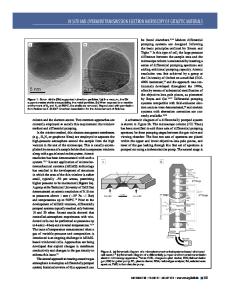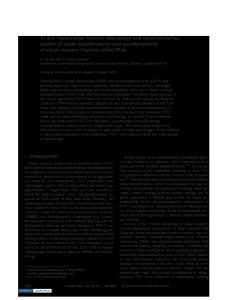Study of deformation behavior of ultrafine-grained materials through in situ nanoindentation in a transmission electron
- PDF / 1,144,309 Bytes
- 6 Pages / 612 x 792 pts (letter) Page_size
- 67 Downloads / 440 Views
A.M. Minor and D. Ge National Center for Electron Microscopy, Lawrence Berkeley National Laboratory, Berkeley, California 94720
J.W. Morris, Jr.a) Department of Materials Science and Engineering, University of California, Berkeley, California 94720 (Received 16 November 2004; accepted 26 January 2005)
The mechanical properties of ultrafine-grained and nanograined materials have received a great deal of recent attention because of their unusual and promising values. However, some of the most important mechanisms of deformation remain unclear. In this work, the deformation behavior of ultrafine-grained Al films and ultrafine-grained Fe is studied through in situ nanoindentation in a transmission electron microscope. Deformation-induced coarsening by grain boundary migration was observed in the ultrafine-grained Al films during deformation at room temperature, whereas no grain boundary motion was found in ultrafine-grained Fe. The lack of grain boundary motion in Fe was attributed to the pinning effect of nano-sized particles at the Fe grain boundaries.
I. INTRODUCTION
Grain refinement is one of the most useful techniques for the strengthening of metallic materials. The yield strength ordinarily increases with decreasing grain size, following the familiar Hall–Petch relation1,2 y ⳱ 0 + Kyd−1/2
,
where d is the mean grain size and 0 and Ky are constants. While there are several possible explanations for the Hall–Petch relation,3 the most widely accepted involve direct interactions between dislocations and grain boundaries. Grain boundaries act as barriers to the dislocation movement, and therefore an increase in the grain boundary volume resulting from grain refinement makes the material harder to deform. Recent advances in methods for grain refinement have led to bulk metals with grain sizes in the submicrometer to nanometer range.4–9 The combination of small grain size and large surface-to-volume ratio gives these socalled ultrafine-grained materials unique properties and leads to special challenges in understanding their
II. EXPERIMENTAL PROCEDURE
a)
Address all correspondence to this author. e-mail: [email protected] DOI: 10.1557/JMR.2005.0216 J. Mater. Res., Vol. 20, No. 7, Jul 2005
http://journals.cambridge.org
deformation. Recent theoretical models and computer simulations suggest that grain boundary-related plasticity mechanisms such as grain boundary sliding and grain rotation dominate at these length scales.10–14 To study the role that grain boundaries may play in ultrafinegrained materials, in situ nanoindentation experiments in a transmission electron microscope (TEM) were carried out to examine the deformation processes directly by TEM. In situ indentation techniques were used in a TEM to study the fracture behaviors of ceramics by driving an indenter into a pre-crack to exert a crack-induced tensile force.15,16 In our study, in situ TEM nanoindentation was used for real time observation of the deformation processes of materials under indentation loads. In this work, the deformation behav
Data Loading...











